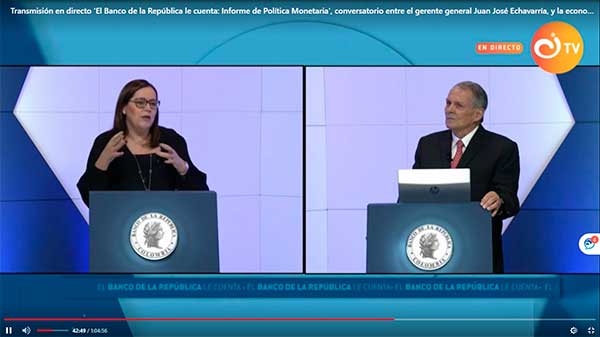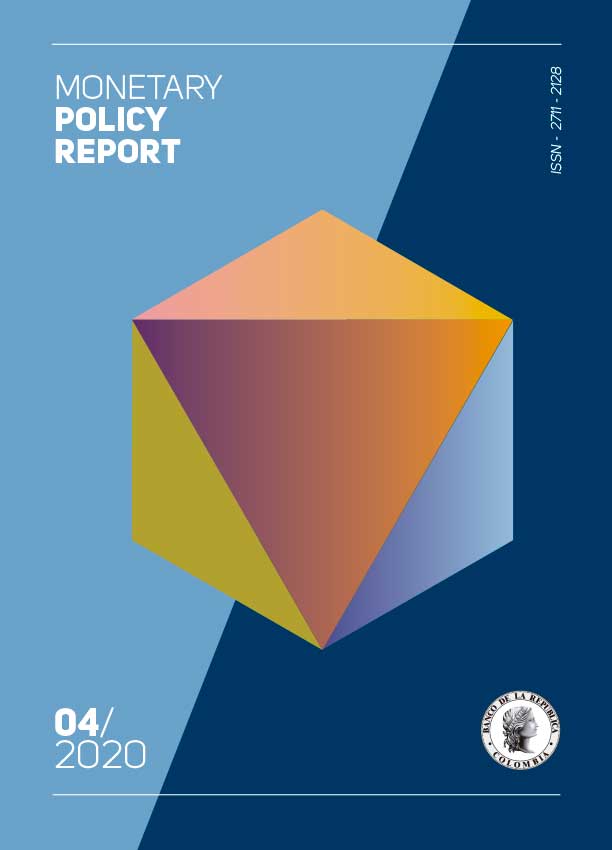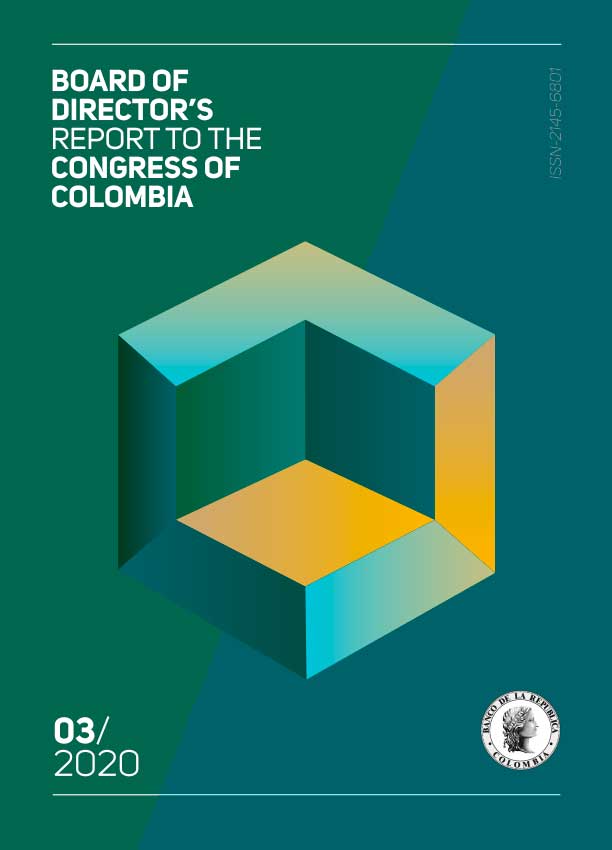Accountability, Communication and Transparency
Transparency is fundamental to accountability on the part of independent central banks. Because they have been granted greater independence, the transparency of these institutions is seen as a mechanism that offers society the ability to assess whether a central bank's actions are consistent with its constitutional mandate. Likewise, greater transparency in defining and executing monetary policy enhances a central bank’s credibility, improves the efficiency of its policies, and helps the markets to operate better.
In various countries, including Colombia, the institutional and legal context provides for a number of elements that allow the actions of central banks to represent the interests of society, directly or indirectly, without affecting their independence. The most important of these is the accountability to Congress, the body that represents the interests of the public and to which central banks submit annual or biannual management reports. Moreover, to ensure central banks act within the limits of their legal mandate, there are bodies that exercise control over their actions, such as legal control over regulations that are issued and disciplinary control over the behavior of the central bank’s officers.
Banco de la República has enjoyed technical, administrative and budgetary independence since the 1991 Constitution. In accordance with the principles of accountability, it makes a tremendous effort to be transparent and to communicate clearly, effectively and in a timely way the strategies, policy decisions and other relevant matters under its management. This effort involves all aspects of the Central Bank's operation, from those related to monetary policy to those linked to cultural affairs, including the management of international reserves; the production of banknotes and coins; procedures for access to liquidity, including emergency liquidity; the Bank's work as a fiscal agent of the government; and its role in promoting the proper functioning of the country's payment systems.
The transparency mechanisms related to the design and execution of monetary, exchange and credit policy, a fundamental function of Banco de la República, include the actions outlined below.
- The objectives of monetary policy are clearly established in the country's constitutional and legal framework. The primary objective of monetary policy is to ensure the purchasing power of money is maintained, in coordination with general economic policy. The objective is clear, prioritized and also quantified: the Bank's Board of Directors must announce each year what the quantitative objective of monetary policy is. As a result, the public can easily verify what the central bank is pursuing and whether or not it is achieving its objective. This is consistent with the constitutional requirement that "the bank, for its part, shall report to Congress on execution of the policies it is responsible for."
- The economic information used by the central bank is known, almost entirely, by the public. The Bank discloses the information the technical staff presents to the Board of Directors for its decision-making and knows the type of models the staff uses, the projections and degree of uncertainty in the inflation forecasts, as well as the forecast range for economic growth (for the year and for the current unpublished quarter).
- The Bank's monetary scheme (inflation targeting) is public knowledge and it makes every effort to ensure that scheme is aired widely and understood by society at large. (i) The quantitative objective and the instruments are disclosed. (ii) A press release is published immediately after each Board meeting, indicating the most relevant elements considered in decision-making. A press conference is held immediately after the meeting to announce and explain the policy decision. The reading of the press release and the question and answer session at the press conference are broadcast in real time through our virtual channel. All videos of the press conferences in the last twelve months are available on our website. (iii) The minutes of the meeting are published, in English and Spanish, on the next business day thereafter, with information gathered by the technical staff and the factors considered by the Board members when making their decision. (iv) The quarterly Monetary Policy Report is published that same day and includes all the public information used by the technical staff to analyze the economy and its prospects. The key concepts in that report are presented live by the General Manager on national television (institutional channel), and members of the public may pose questions live by telephone, in person or virtually.
The Monetary Policy Report
The Board of Directors of Banco de la República analyzes the following data monthly and within the framework of the Monetary Policy Report.
- Consumer and producer price series
- Core inflation measurements
- Output and spending indicators
- Money, credit, interest rate and asset price series
- International economic indicators: global growth and that of Colombia’s major trading partners, liquidity, and foreign interest rates
Live program ‘The Bank of the Republic Reports’
 ‘The Banco de la Republica reports’ is a televised program in which the Governor of the Bank explains the most important points in the institutional reports (Monetary Policy Report, Report of the Board of Directors to the Congress of the Republic, and the Financial Stability Report), answers questions from Colombians, and reports news from the Bank. This program is broadcast live on “Canal Institucional” (channel 9 on national television) and on our virtual channels.
‘The Banco de la Republica reports’ is a televised program in which the Governor of the Bank explains the most important points in the institutional reports (Monetary Policy Report, Report of the Board of Directors to the Congress of the Republic, and the Financial Stability Report), answers questions from Colombians, and reports news from the Bank. This program is broadcast live on “Canal Institucional” (channel 9 on national television) and on our virtual channels.
Report by the Board of Directors to the Congress of the Republic of Colombia
As provided for in Article 5 of Law 31 of 1992, the Board of Directors of Banco de la República submits a report to Congress once a year, giving an account of how the economic has performed and its outlook for the future. The report is presented within ten working days of the date the congressional sessions begin (in March and July).
An assessment of the macroeconomic performance that has been observed, including a careful analysis of the various shocks to the economy, is published in the Board of Directors' Report to Congress. It explains the reasons why inflation may have deviated from the target, if this indeed occurred, and presents a vision of where the Bank believes the economy is headed in the near future. These reports include an explanation of the rationale behind the decisions taken by the Board of Directors with respect to monetary, foreign exchange and credit policy. There is also a description of the level of international reserves and Banco de la República’s financial situation.
The report covers:
- Economic activity and employment
- Monetary and exchange policy
- Fiscal policy
- Balance of payments
- Level and management of international reserves
- Banco de la República’s financial situation
In other words, the general public and local and international markets are provided with all relevant information on the monetary policy decision-making process (the "inflation targeting strategy"), the assessment that is made and the rationale behind the decisions on policy, as well as the procedures that are followed. Moreover, an effort is made to make such information understandable and timely. In this way, the Bank complements its constitutional and legal obligation to present a report on its management to Congress twice a year, in return for the Bank's independence, and to guide the public’s expectations about how monetary policy is being managed. This, in turn, contributes to its efficiency and reduces unnecessary volatility in the markets.
With respect to the Bank’s transparency and accountability in terms of its other functions, the following information is relevant. The reports submitted to Congress by the Board of Directors always have two specific chapters: one on how international reserves are managed and another on the Bank’s financial performance. The chapter on reserve management explains the management criteria and gives an account of the results obtained, in addition to providing detailed information on the bank's income and expenses. A duly audited balance sheet is presented in the final chapter. All this information is available to Congress and the public, and members of Congress may make detailed comments and ask questions on any topic in the report.
The Bank also regularly publishes the Payment Systems Report and the Financial Stability Report. The former contains a detailed analysis of the performance of payment systems and the actions taken by Banco de la República with respect to that function. The Financial Stability Report identifies risks to the country's financial system associated with macroeconomic factors or with the performance of the financial system’s clients (families, companies, government).








































































